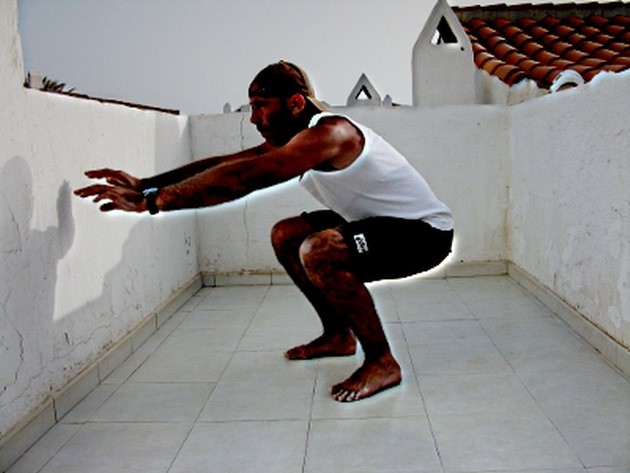
half squats
But they also engage some stabilizing muscles: your lower back (erector spinae), the outside of your thighs and bum (abductors), your inner thighs (adductors) and your calves (gastrocnemius and soleus).
Squats should normally be performed with your thighs at least parallel with the floor, but going lower through the whole range of motion will constitute ‘deep squats’. The heels normally remain in contact with the floor, though in some variations you can raise on your toes (hindu squats).
When performing squats, you should ensure that your back remains in a neutral position, and that you head stays aligned with your body. Your knees should remain in alignment with your toes at all times.
The following progression will take you to a one legged squat (pistol squat).
Start at whichever point of the progression is relevant to you.
Unless otherwise indicated, you should be aiming to complete 6 sets of 6 repetitions of the given exercise within a workout.
The first set is a warm up set: go back two or three levels in the progression and perform that variation for 6 reps.
Perform each following set ‘to failure’ (e.g. 6,6,5,5,4).
In each new workout, you should aim to improve on the number of reps you performed previously by at least 1, e.g.: (6,6,5,5,4) → (6,6,6,5,4)
Once you manage 6 sets of 6 reps, you are ready to move on to the next variation in the progression.
If you find yourself not progressing any longer, take a few rest days, then resume training.
1. Assisted squats – Rest your hands on the back of a chair in front you. Lower yourself till your thighs are parallel with the floor, and come back up, using the chair as a support.
2. Deep assisted squats – Same as above, but squat through the full range of motion.
3. Half squats – Without any help, lower yourself till your thighs are parallel with the floor, and come back up.
4. Deep squats – Same as above, but squat through the full range of motion.
5. Bulgarian split squats. Rest your back foot on an elevated platform, with the sole pointing up. Keep your weight over your front leg as you lower yourself.
6. Assisted half one-legged squats – Performed with a chair next to you, extend one leg straight in front of you, and lower yourself till your thigh is parallel with the floor. Help yourself back up with the chair.
7. Door frame half one-legged squats – Same as above, but using a door or door frame mainly for support and balance.
8. Half one-legged squats – As above but without the help of the chair or door.
9. Assisted 3/4 one-legged squats – As above, but going down three quarters of the way.
10. Door frame 3/4 one-legged squat – Using a door or door frame mainly for support and balance.
11. 3/4 one-legged squat – Unsupported.
12. Assisted one-legged squats – With a chair next to you, extend one leg straight in front of you, and lower yourself through the full range of motion. Help yourself with the chair on the way up.
13. Door frame one-legged squats – Using a door or door frame mainly for support and balance.
14. One-legged squats (pistol squats) – Same as above, without the help of the chair.
15. Modified one-legged squats – a pistol squat performed with what would normally be your front leg being held in your hand.
SNEAKY TIP! Still having difficulties achieving one-legged squats? If you’re struggling with the transition from ‘door frame one-legged squats’ to unsupported ones, here’s a counter-intuitive trick which will get you there in no time: do weighted one-legged squats (you can use dumbbells if you have some, but any heavy object will do just as well). The weight counter balances your body and makes it easier to lower yourself to the bottom position. Start with a 5kg weight and, once you achieve 5×6 reps, move down in weight progressively in 1 kg increments until you can do pistols.
Read more volleyball articles from our Fitness section.
Check out our Stretching section, every Sunday a new story, tomorrow read about 2 Essential Quad Stretches for Athletes